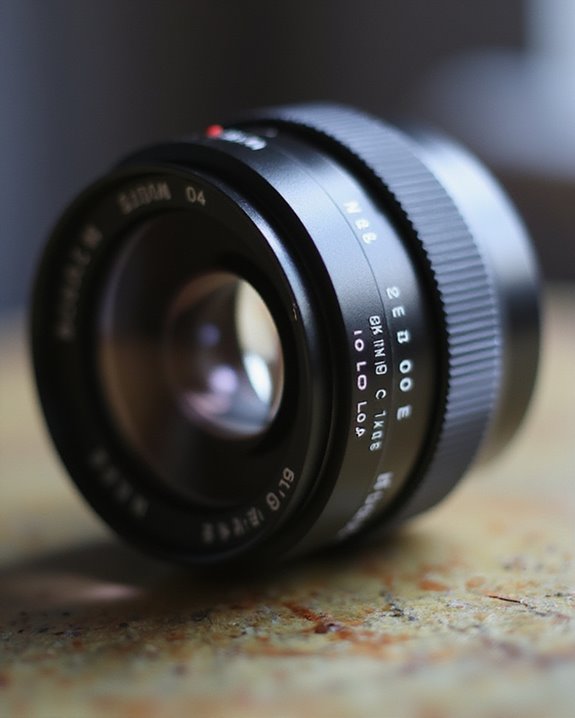Camera lens numbers convey critical specifications that impact performance and compatibility. Focal length (18-55mm) indicates field of view range, with lower numbers capturing wider angles and higher numbers providing magnification. Maximum aperture (f/2.8) reveals light-gathering ability and depth of field potential, with lower f-numbers allowing more light. Mount designations guarantee proper camera fit, while filter thread size (Ø67mm) specifies accessory compatibility. Understanding these numerical codes helps photographers select equipment that matches their specific shooting requirements and technical needs.
Key Takeaways
- Focal length numbers (like 18-55mm) indicate the lens’s angle of view, with lower numbers capturing wider scenes and higher numbers magnifying subjects.
- Aperture numbers (like f/2.8) represent light-gathering ability, with smaller f-numbers indicating wider openings for better low-light performance and background blur.
- Filter thread size (marked as Ø followed by a number) shows the diameter in millimeters for compatible filters and accessories.
- Mount designations (like E-mount or RF) specify which camera brands and bodies the lens will physically attach to.
- Element/group specifications (such as 15 elements in 10 groups) reveal the internal optical construction that affects image quality and correction.
Decoding the Focal Length: 18-55mm and What It Means
What exactly do those numbers on a camera lens signify? The 18-55mm designation represents the focal length range, indicating how wide or zoomed the lens can capture images. At 18mm, photographers obtain a wider angle of view, ideal for landscapes and architecture, while the 55mm end narrows the field for more magnified subjects, suitable for portraits.
This Focal Variation directly influences what appears in the frame, with lower numbers capturing broader scenes and higher numbers creating a more zoomed effect. The range also creates distinct Perspective Effects—wider focal lengths may introduce edge distortion, while longer focal lengths compress the scene visually, flattering portrait subjects by reducing facial distortions. This standard zoom range offers versatility for beginners and experienced photographers alike, providing flexibility for various shooting scenarios without changing lenses. Additionally, understanding the optical quality of different lenses helps photographers make better choices for their specific needs.
Understanding Maximum Aperture: The F-Stop Mystery Solved

Perhaps the most misunderstood number on a camera lens, the f-stop designation reveals a lens’s maximum aperture capability, which photographers must grasp to achieve their creative vision. Expressed as numbers like f/1.8 or f/4, these values inversely relate to aperture size—lower numbers indicate wider openings and greater light intake. The maximum aperture directly influences a photographer’s ability to create subject isolation through shallow depth of field effects, particularly in portrait photography.
Professional lenses often feature wider maximum apertures (f/2.8 or lower), enabling superior low-light performance without sacrificing shutter speed. While prime lenses typically offer the widest apertures for dramatic background blur, constant-aperture zoom lenses maintain consistent exposure throughout their focal range, making them valuable for professional work despite their higher cost.
Lens Compatibility Labels and What They Tell You
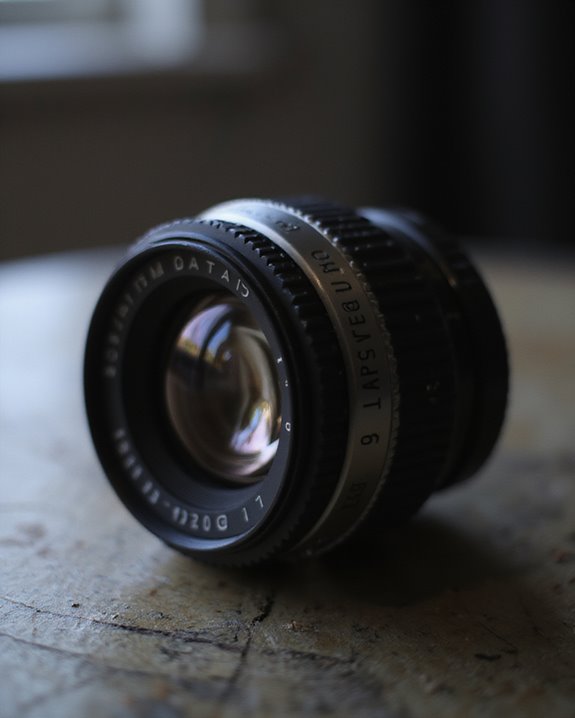
The cryptic array of letters and numbers adorning modern camera lenses serves as an essential compatibility code that photographers must decipher before making purchasing decisions. Mount designations like “E-mount” (Sony) or “RF” (Canon) directly indicate which camera bodies will accept the lens without adapters, while Format Labels provide critical information about sensor coverage. Full-frame designations such as “FE” (Sony) or “FX” (Nikon) indicate lenses designed for larger sensors, whereas “DX” or “EF-S” signify crop-sensor compatibility. Understanding lens compatibility labels ensures optimal performance and prevents compatibility issues with your camera system. Hybrid Mounts, often requiring compatibility converters, may not be explicitly labeled on the lens barrel, necessitating research before purchase. Manufacturers further differentiate product tiers through additional codes—Canon’s “L” series or Sony’s “G Master” indicating professional-grade optics, while weather-sealing abbreviations like “WR” denote environmental protection capabilities.
The Filter Thread Size: What Ø67mm Actually Represents
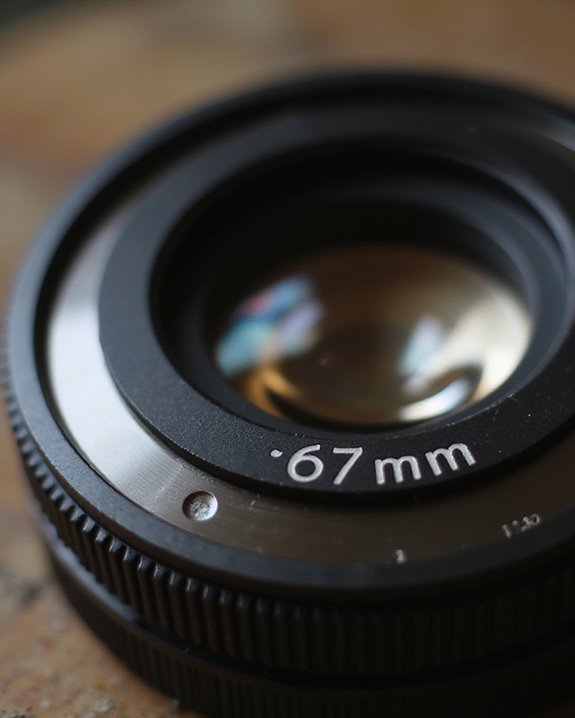
Among the essential specifications marked on a camera lens, filter thread size plays a crucial role in determining filter compatibility and maintaining image quality. The symbol “Ø” followed by a number in millimeters, such as Ø67mm, indicates the diameter of the circular thread at the front of the lens where filters attach. This standardized measurement system, evolved throughout thread history, guarantees photographers can select appropriate filters without guesswork. Properly matching the filter size to the lens ensures optimal image quality and avoids issues like vignetting. Common thread sizes range from 52mm for compact lenses to 82mm or larger for professional telephoto options. Filter adaptation through step-up or step-down rings allows photographers to use filters across lenses with different thread sizes, though this practice may introduce vignetting with wider angle lenses. Proper thread size selection prevents light obstruction and guarantees ideal performance when using filters.
Optical Elements and Groups: The Technical Numbers That Matter
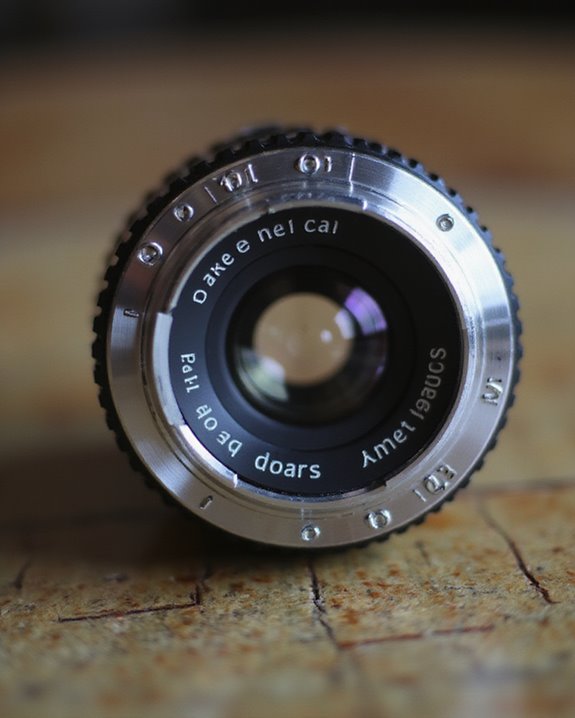
Understanding optical elements and groups requires familiarity with the complex numerical specifications found on camera lenses, which directly impact image quality and performance capabilities. These specifications, often written as “15 elements in 10 groups” or similar configurations, reveal the internal construction of the lens.
Aspherical Elements, which correct spherical aberration and distortion, represent specialized components within these groups that enhance image sharpness across the entire frame. Manufacturers utilize these precision-engineered surfaces to reduce optical flaws without requiring excessive weight or size. Additionally, Cemented Lenses combine multiple glass elements into a single unit, improving mechanical stability while reducing internal reflections. This technique allows designers to incorporate different glass types with complementary optical properties, effectively minimizing chromatic aberrations and enhancing overall image quality without dramatically increasing the physical dimensions of the lens.
Image Stabilization Ratings: What the Numbers Tell About Shake Reduction
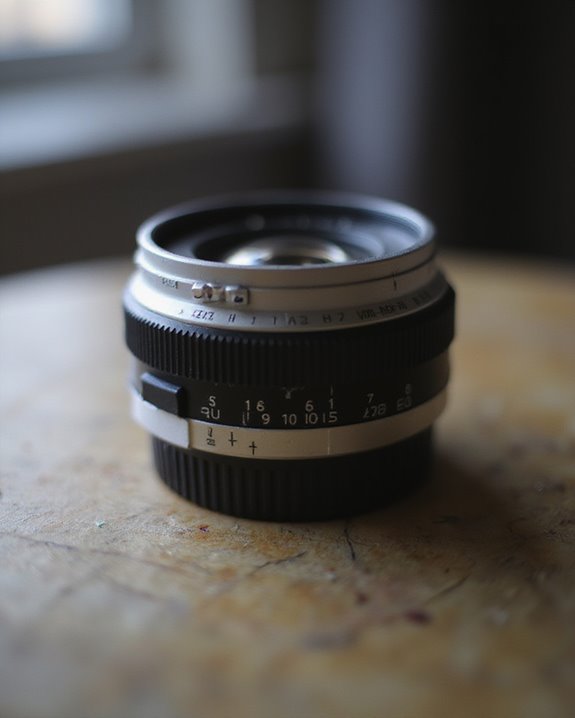
When photographers examine lens specifications, image stabilization ratings provide essential information about a lens’s ability to counteract camera shake, typically measured in “stops” of compensation. These Stabilization Stops indicate how many shutter speed increments slower than normal a photographer can shoot while maintaining sharpness, with most modern lenses offering between 4-6 stops of stabilization.
The Shake Metrics translate to real-world advantages, allowing photographers to use considerably slower shutter speeds than normally possible, such as 1/15th instead of 1/500th of a second. Different manufacturers employ unique stabilization systems—Canon’s O.I.S, Nikon’s VR, and Sony’s OSS—with varying effectiveness. This feature proves particularly beneficial for telephoto lenses where camera movement is magnified, though photographers should note that while stabilization addresses camera shake, it cannot compensate for subject motion.
Lens Generations and Product Codes: Making Sense of Model Numbers
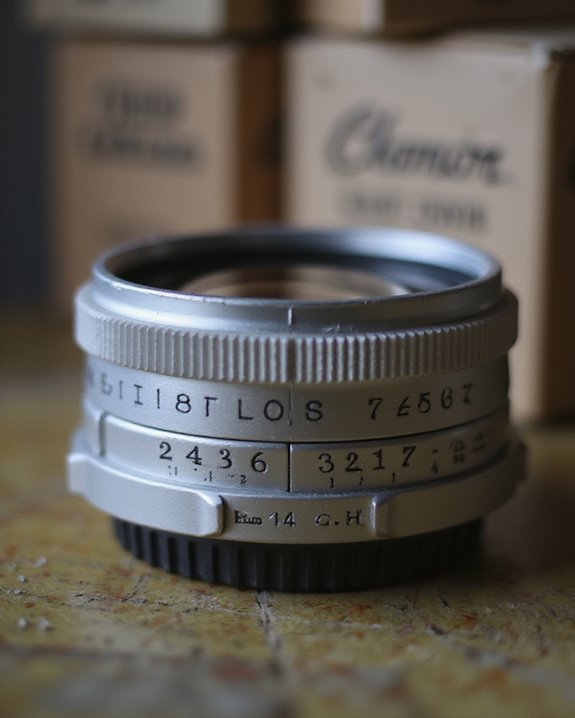
Deciphering lens generations and product codes represents an essential skill for photographers maneuvering the complex world of camera equipment. Manufacturers follow consistent Code Standards when creating model numbers, typically incorporating focal length, maximum aperture, and generation indicators like “II” or “III” to signify updated versions. These designations reflect tangible improvements in optical performance, construction quality, or technological integration rather than mere marketing distinctions.
Upgrade Cycles often coincide with technological advancements, addressing limitations in previous models or introducing entirely new capabilities. Product codes further specify mount compatibility (such as Canon’s EF versus EF-S), specialized features, and intended use cases. By understanding these systematic naming conventions, photographers can make informed decisions about lens purchases, compatibility with existing equipment, and the significance of generational improvements that may justify investment in newer models.
Frequently Asked Questions
How Do Lens Numbers Affect the Price of Camera Lenses?
Lens pricing rises with extreme focal lengths, and aperture impact is significant. Smaller f-numbers demand larger glass elements, specialized construction increases costs, and market demand elevates prices for sought-after specifications or vintage optics.
Can Vintage Lens Numbers Be Translated to Modern Equivalents?
Vintage lens numbers can be translated through Lens Adaptation charts and Historical Conversion tables. While f-stop systems may differ, most vintage aperture values intersect with modern equivalents at f/16, enabling practical contemporary use.
How Do Atmospheric Conditions Affect Lens Performance Numbers?
Atmospheric conditions impact lens performance greatly. Weather distortion can alter focus accuracy and resolution values, while humidity effects can compromise optical clarity and increase the need for weather-sealed equipment with higher durability ratings.
What Do the Numbers on Third-Party Versus Manufacturer Lenses Indicate?
Numbers on third-party and manufacturer lenses indicate identical specifications using standardized measurements. Both display focal length in millimeters and aperture in f-stops, ensuring lens compatibility despite minor variations in proprietary feature designations.
How Do Lens Numbers Correlate With Camera Sensor Sizes?
Like puzzle pieces finding their match, lens numbers require Sensor Correlation understanding. The focal length effectively changes with different sensor sizes, necessitating Focal Adaptation calculations using crop factors to determine equivalent field-of-view perspectives.

